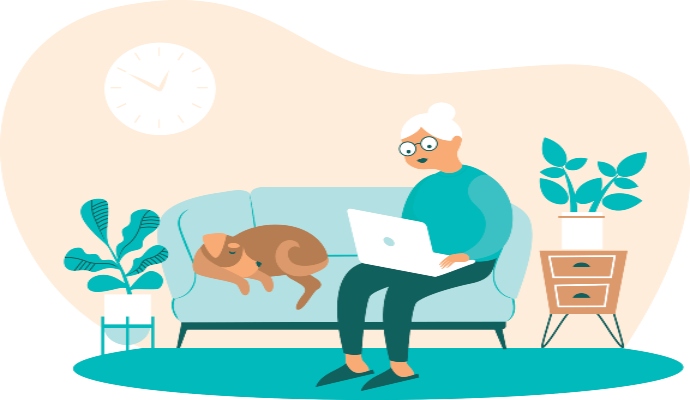
Virtual Care Technologies to Support Aging in Place
The United States population is aging — and aging fast. With the proportion of US adults 65 and over projected to skyrocket to 95 million people by 2060, healthcare utilization will undoubtedly grow, exacerbating an already overwrought system. Virtual care can play a critical role in managing the added pressure by supporting seniors as they age in place.
According to the National Institute on Aging, aging in place means “staying in your own home as you get older.” Most adults aged 50 to 80 (88 percent) feel that it is important to remain in their homes for as long as possible, results from a 2022 survey show.
However, seniors who want to age in place must ensure they have adequate support at home for personal care, household chores, meals, and healthcare, among other services. Healthcare technologies have emerged as vital tools to support seniors’ aging in place.
A survey conducted by U.S. News & World Report in March 2023 revealed that 53 percent of older adults use some type of assistive or health-related technology. The survey polled 2,000 US adults 55 and older. Additionally, 88 percent of survey respondents believe that assistive or health-related technologies have improved their quality of life.
Here, mHealthIntelligence details some of the virtual care and mHealth technologies that can support aging in place.
TELEHEALTH PLATFORMS
Telehealth, which saw an unprecedented rise among all age groups during the COVID-19 pandemic, can play a significant role in helping seniors remain in their homes for as long as possible.
Telehealth encompasses various technology-based strategies for connecting patients and healthcare providers. These connections can be synchronous, occurring in real time through audio-visual or audio-only means, or asynchronous, with patients providing information or photos to their provider, who reviews them and respond at a later time.
Thus, telehealth enables older adults to access healthcare without leaving their homes, organizing transportation, and navigating unfamiliar spaces. The risk of seniors contracting illnesses in a medical clinic is also lower with telehealth use.
Telehealth requires access to various types of technology, including desktop computers, tablets, and smartphones. Though this may have been a hurdler for older adults, the population has become increasingly familiar with technology over the past decade.
A 2021 Pew Research Center survey shows that 61 percent of those 65 and older own a smartphone compared to 96 percent of those ages 18 to 29, but that gap has decreased by 18 percentage points since 2012. Additionally, 44 percent of older adults own tablets, and 75 percent report being internet users.
In addition, during the COVID-19 pandemic, many seniors used technology to access care. A study published in March 2022 reveals that telehealth use among older Medicare beneficiaries rose to 21.1 percent during the pandemic from 4.6 percent pre-pandemic. And not only that, but adults older than 64 reported being satisfied with telehealth in a 2021 study and most wanted virtual care options to remain available.
HEALTHCARE WEARABLES
Wearable technologies, electronic devices designed to be worn on the user’s body, are becoming increasingly popular in healthcare. According to an article in PLOS Digit Health, healthcare-focused wearables have four main functions: monitoring, screening, detection, and prediction. These functions can support seniors remaining in their homes by helping them, their caregivers, and clinical care teams keep track of their health and well-being.
For instance, physical sensors worn on the body can track physical signals of the human body continuously and over time. These devices can measure basic vital signs like heart rate, electrocardiogram (ECG), respiration rate, body temperature, and blood pressure, and detect fall events or assess the gait disorders of Parkinson’s disease patients, a research article in Nature Medicine notes.
Then, there are wearable platforms for monitoring health parameters at the molecular level. These non-invasive chemical sensors are designed to capture molecular data from the human body in real time. These sensors track the changing chemical composition of various biofluids, such as sweat, tears, saliva, and interstitial fluid, and blood sugar levels in diabetes patients, like continuous glucose monitors (CGMs).
Further, hybrid wearable devices have been developed to simultaneously track chemical biomarkers and physical vital signs using single multi-modal epidermal patches.
These healthcare-focused wearable devices have numerous use cases that make them effective at helping seniors age in place, including screening for sleep apnea, detecting atrial fibrillation, and predicting the flu and common cold before symptoms occur.
MHEALTH APPLICATIONS
mHealth applications can support aging in place in several ways, including by promoting healthy behaviors, offering mental health and wellbeing services, and alleviating loneliness. Enabling older adults to access these benefits from their smartphones, tablets, or computers in their homes helps them continue living independently.
About 28 percent of Americans between 50 and 80 use at least one mhealth app, according to a survey by the University of Michigan Institute for Health Policy and Innovation. The survey polled 2,110 in August 2021. It further reveals that 34 percent of older adults said they use or have used apps for exercise, 22 percent for nutrition, 20 percent for weight loss, and 17 percent for sleep.
Research shows that mHealth apps can help increase physician activity in older adults. Published in 2020, a review of studies from multiple databases concluded that “mHealth may be acceptable and may be an effective tool to increase PA [physical activity] or exercise in older people.”
Fewer older adults use mHealth apps for mental health or social isolation-related needs. The University of Michigan survey shows that only 9 percent use or have used apps to record blood pressure, 8 percent to meditate, and 5 percent to manage mental health and stress.
However, in a study published in September 2023, the researchers observed that engaging with mHealth chatbots “led to improvements in well-being and stress reduction, as well as a decrement in depressive symptoms” among older adults. Texas researchers also found that mHealth apps can help families stay connected with older adults and link them to resources that encourage physical and mental well-being.
MEDICAL ALARM SYSTEMS
Falling is a significant risk for older adults. In 2018, 27.5 percent of adults 65 or older reported at least one fall in the past year, resulting in around 35.6 million falls, data from the Centers for Disease Control and Prevention (CDC) shows. About 10.2 percent of the falls (8.4 million) resulted in a fall-related injury.
Thus, preventing falls, especially among seniors living at home, is paramount. Medical alarm systems help bring necessary services quickly and efficiently to seniors who have fallen.
According to the National Council on Aging, medical alarm systems connect users with a 24/7 monitoring center, whose staff then dispatches emergency services to the user’s location. These devices use various capabilities to connect users with the monitoring centers, including a button, fall detection sensors, or voice commands.
These tools are also available as wearable devices worn as a necklace or carried around in a pocket. Some devices use accelerometers that detect a fall and automatically send an alert to the monitoring center. Some have GPS tracking to help emergency response teams reach the user’s location in the shortest time possible.
Automatic fall detection and GPS tracking are the top two capabilities users want in their medical alarm systems, a National Council on Aging Reviews Team survey shows. The survey polled 1,000 medical alert system users. Other popular medical alarm system capabilities include a mobile app for caregivers, voice recognition, and heart monitoring.
MEDICATION REMINDER TOOLS
As people age, the list of medications they need grows. But concurrently, memory may fade. This results in seniors forgetting to take their medications, a major barrier to aging in place.
According to 2019 data from KFF, 89 percent of adults 65 and older report taking any prescription medicine. More than half report taking four or more prescription drugs. Additionally, more than half of seniors with memory issues, such as dementia, are more likely to take six or more medications regularly, a UC San Francisco-led study reveals.
Medication nonadherence is a challenge, especially among older adults taking multiple medications. One study published in 2008 revealed that of 343 patients 65 and older, 79 percent reported forgetting a dose less than once a week, 15.17 percent forgot once or twice a week, and 5.06 percent forgot their medications more than twice a week. Among those taking one or more prescription drugs, 18.26 percent missed doses or took too much medication more than twice weekly but tried to keep up with medications.
Technology can help seniors remember to take their medications on time. A 2019 AARP survey shows that about 40 percent of 2,607 respondents were interested in using technology that would remind them to take medicine and tell their healthcare provider if they took it.
There are medication reminder tools, including electronic pill bottles or boxes, ingestible sensors, electronic medication management systems, and blister pack technology, which have attachable adhesive labels containing a microchip that records the date and time a medication was taken.
Medication reminder tools also come in the form of video-based technologies, where older adults take medication while on a video call with a healthcare provider, and motion sensor technologies, which are typically worn on the wrist and include triaxial accelerometer capabilities that identify the medication administration movements of patients.
Technology is a critical aspect of enabling seniors to age in place. As older adults increasingly desire to remain at home as long as possible, developing virtual care technologies will be integral to making that desire a reality.
